LDHA Rabbit Polyclonal Antibody

cat.: ER00702
| Product Type: | Rabbit polyclonal IgG, primary antibodies |
|---|---|
| Species reactivity: | Human, Mouse, Rat |
| Applications: | WB, IHC-P, FC, IF-Cell |
| Clonality: | Polyclonal |
| Form: | Liquid |
| Storage condition: | Shipped at 4℃. Store at +4℃ short term (1-2 weeks). It is recommended to aliquot into single-use upon delivery. Store at -20℃ long term. |
| Storage buffer: | 1*PBS (pH7.4), 0.2% BSA, 40% Glycerol. Preservative: 0.05% Sodium Azide. |
| Concentration: | 1ug/ul |
| Purification: | Immunogen affinity purified. |
| Molecular weight: | Predicted band size: 37 kDa |
| Isotype: | IgG |
| Immunogen: | Synthetic peptide within Human LDHA aa 1-50 / 332. |
| Positive control: | A431 cell lysate, MCF7 cell lysate, NIH/3T3 cell lysate, RAW264.7 cell lysate, C6 cell lysate, PC-12 cell lysate, human liver tissue, mouse liver tissue, rat liver tissue, A431, RAW264.7, C6. |
| Subcellular location: | Cytoplasm. |
| Recommended Dilutions:
WB IHC-P FC IF-Cell |
1:5,000 1:1,000 1:1,000 1:100 |
| Uniprot #: | SwissProt: P00338 Human | P06151 Mouse | P04642 Rat |
| Alternative names: | Cell proliferation-inducing gene 19 protein GSD11 L lactate dehydrogenase A chain L-lactate dehydrogenase A chain l7R2 Lactate dehydrogenase 1, A chain Lactate dehydrogenase A Lactate dehydrogenase A4 Lactate dehydrogenase M LDH A LDH M LDH muscle subunit LDH muscle subunit; M LDH LDH-A LDH-M LDH1 ldha LDHA_HUMAN LDHM OTTMUSP00000017774 PIG19 Proliferation-inducing gene 19 Renal carcinoma antigen NY-REN-59 |
Images
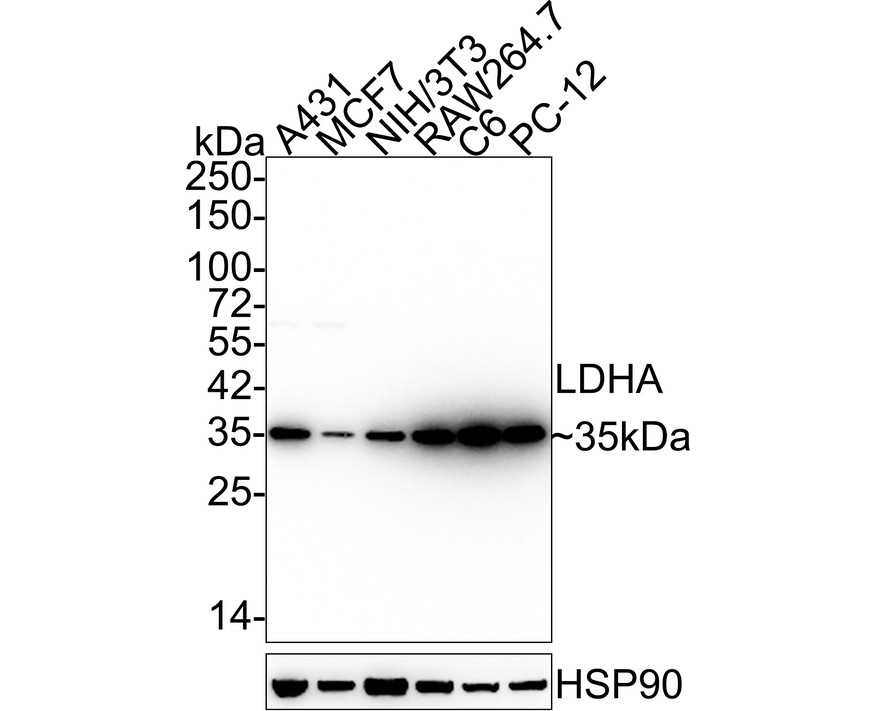
|
Fig1:
Western blot analysis of LDHA on different lysates with Rabbit anti-LDHA antibody (ER00702) at 1/5,000 dilution. Lane 1: A431 cell lysate Lane 2: MCF7 cell lysate Lane 3: NIH/3T3 cell lysate Lane 4: RAW264.7 cell lysate Lane 5: C6 cell lysate Lane 6: PC-12 cell lysate Lysates/proteins at 15 µg/Lane. Predicted band size: 37 kDa Observed band size: 35 kDa Exposure time: 20 seconds; 4-20% SDS-PAGE gel. Proteins were transferred to a PVDF membrane and blocked with 5% NFDM/TBST for 1 hour at room temperature. The primary antibody (ER00702) at 1/5,000 dilution was used in 5% NFDM/TBST at 4℃ overnight. Goat Anti-Rabbit IgG - HRP Secondary Antibody (HA1001) at 1/50,000 dilution was used for 1 hour at room temperature. |
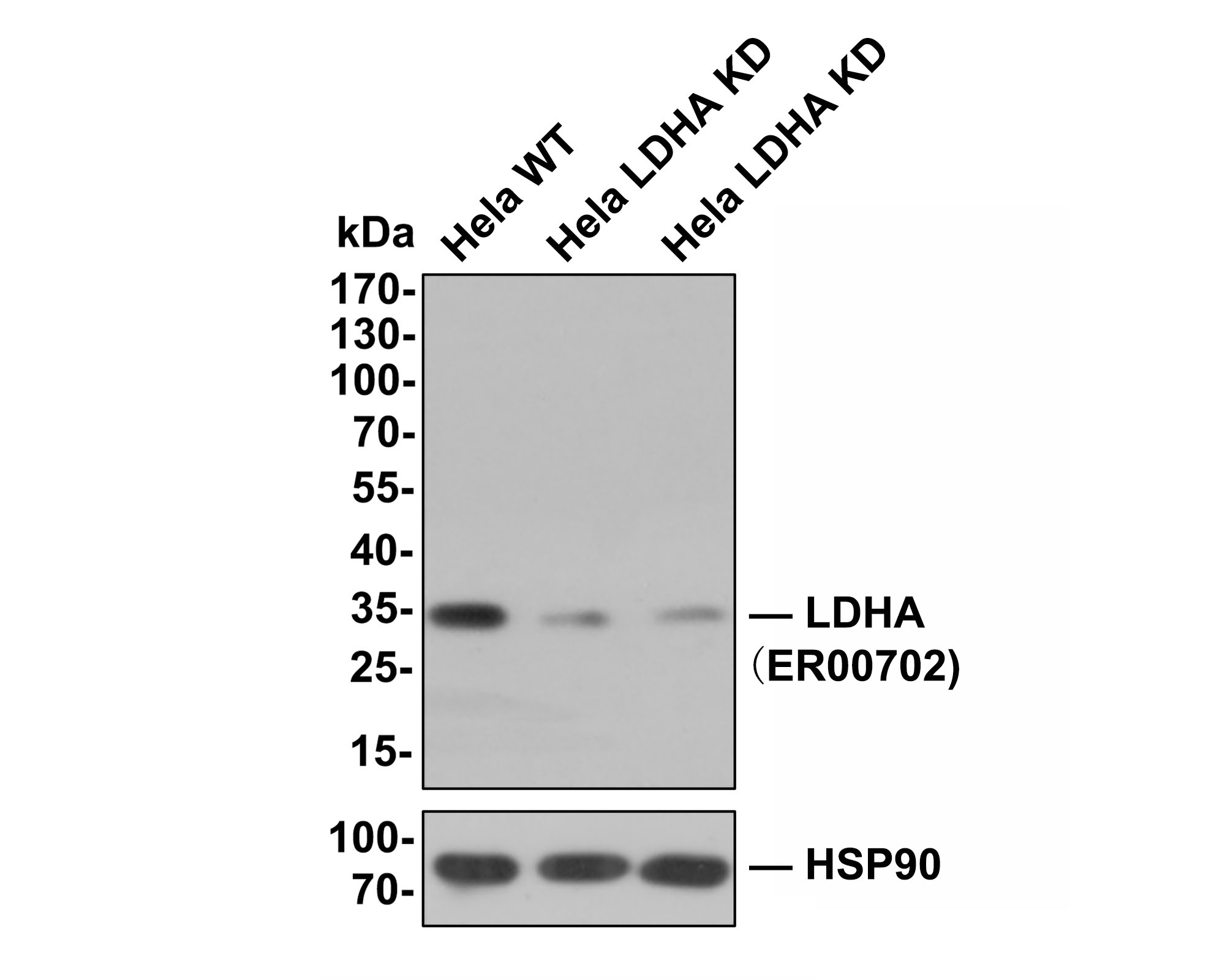
|
Fig2:
All lanes: Western blot analysis of LDHA with anti-LDHA antibody (ER00702) at 1:500 dilution. Lane 1: Wild-type Hela whole cell lysate (10 µg). Lane 2/3: LDHA knockdown Hela whole cell lysate (10 µg). ER00702 was shown to specifically react with LDHA in wild-type Hela cells. Weakened bands were observed when LDHA knockdown samples were tested. Wild-type and LDHA knockdown samples were subjected to SDS-PAGE. Proteins were transferred to a PVDF membrane and blocked with 5% NFDM in TBST for 1 hour at room temperature. The primary antibody (ER00702, 1:500) was used in 5% BSA at room temperature for 2 hours. Goat Anti-Rabbit IgG-HRP Secondary Antibody (HA1001) at 1:300,000 dilution was used for 1 hour at room temperature. |
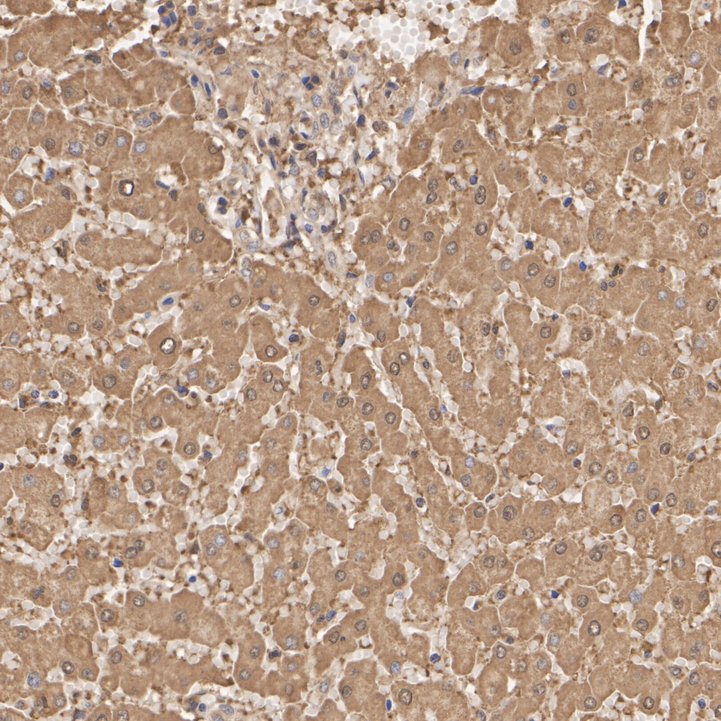
|
Fig3:
Immunohistochemical analysis of paraffin-embedded human liver tissue with Rabbit anti-LDHA antibody (ER00702) at 1/1,000 dilution. The section was pre-treated using heat mediated antigen retrieval with Tris-EDTA buffer (pH 9.0) for 20 minutes. The tissues were blocked in 1% BSA for 20 minutes at room temperature, washed with ddH2O and PBS, and then probed with the primary antibody (ER00702) at 1/1,000 dilution for 1 hour at room temperature. The detection was performed using an HRP conjugated compact polymer system. DAB was used as the chromogen. Tissues were counterstained with hematoxylin and mounted with DPX. |

|
Fig4:
Immunohistochemical analysis of paraffin-embedded mouse liver tissue with Rabbit anti-LDHA antibody (ER00702) at 1/1,000 dilution. The section was pre-treated using heat mediated antigen retrieval with Tris-EDTA buffer (pH 9.0) for 20 minutes. The tissues were blocked in 1% BSA for 20 minutes at room temperature, washed with ddH2O and PBS, and then probed with the primary antibody (ER00702) at 1/1,000 dilution for 1 hour at room temperature. The detection was performed using an HRP conjugated compact polymer system. DAB was used as the chromogen. Tissues were counterstained with hematoxylin and mounted with DPX. |
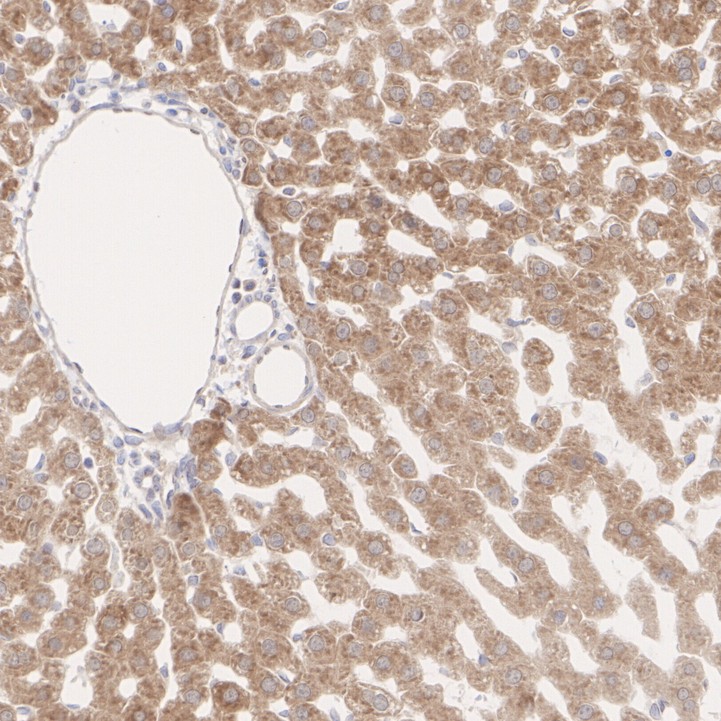
|
Fig5:
Immunohistochemical analysis of paraffin-embedded rat liver tissue with Rabbit anti-LDHA antibody (ER00702) at 1/1,000 dilution. The section was pre-treated using heat mediated antigen retrieval with Tris-EDTA buffer (pH 9.0) for 20 minutes. The tissues were blocked in 1% BSA for 20 minutes at room temperature, washed with ddH2O and PBS, and then probed with the primary antibody (ER00702) at 1/1,000 dilution for 1 hour at room temperature. The detection was performed using an HRP conjugated compact polymer system. DAB was used as the chromogen. Tissues were counterstained with hematoxylin and mounted with DPX. |

|
Fig6:
Immunocytochemistry analysis of A431 cells labeling LDHA with Rabbit anti-LDHA antibody (ER00702) at 1/100 dilution. Cells were fixed in 4% paraformaldehyde for 20 minutes at room temperature, permeabilized with 0.1% Triton X-100 in PBS for 5 minutes at room temperature, then blocked with 1% BSA in 10% negative goat serum for 1 hour at room temperature. Cells were then incubated with Rabbit anti-LDHA antibody (ER00702) at 1/100 dilution in 1% BSA in PBST overnight at 4 ℃. Goat Anti-Rabbit IgG H&L (iFluor™ 488, HA1121) was used as the secondary antibody at 1/1,000 dilution. PBS instead of the primary antibody was used as the secondary antibody only control. Nuclear DNA was labelled in blue with DAPI. Beta tubulin (M1305-2, red) was stained at 1/100 dilution overnight at +4℃. Goat Anti-Mouse IgG H&L (iFluor™ 594, HA1126) was used as the secondary antibody at 1/1,000 dilution. |
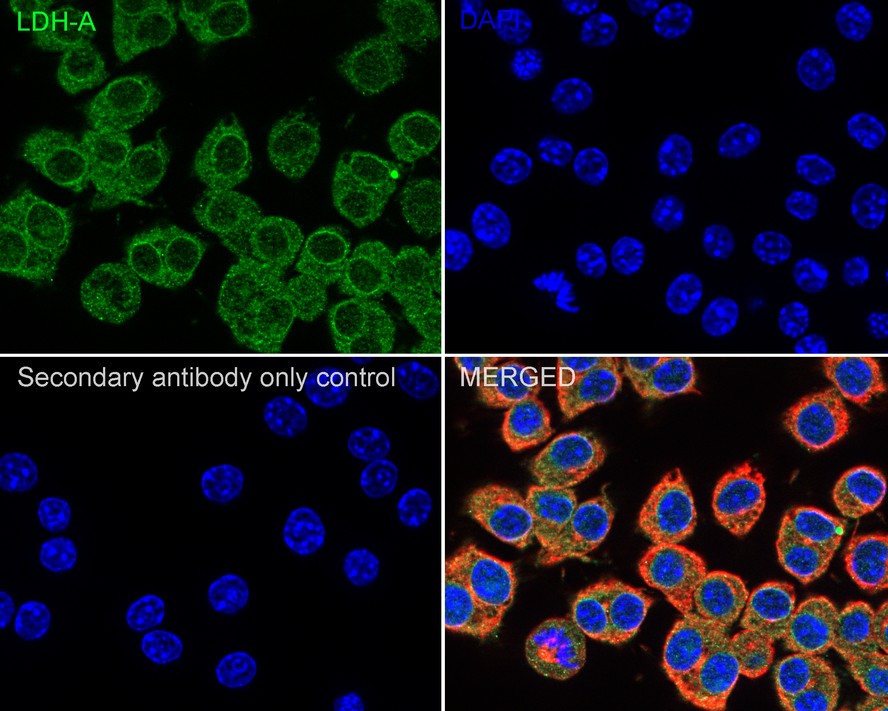
|
Fig7:
Immunocytochemistry analysis of RAW264.7 cells labeling LDHA with Rabbit anti-LDHA antibody (ER00702) at 1/100 dilution. Cells were fixed in 4% paraformaldehyde for 20 minutes at room temperature, permeabilized with 0.1% Triton X-100 in PBS for 5 minutes at room temperature, then blocked with 1% BSA in 10% negative goat serum for 1 hour at room temperature. Cells were then incubated with Rabbit anti-LDHA antibody (ER00702) at 1/100 dilution in 1% BSA in PBST overnight at 4 ℃. Goat Anti-Rabbit IgG H&L (iFluor™ 488, HA1121) was used as the secondary antibody at 1/1,000 dilution. PBS instead of the primary antibody was used as the secondary antibody only control. Nuclear DNA was labelled in blue with DAPI. Beta tubulin (M1305-2, red) was stained at 1/100 dilution overnight at +4℃. Goat Anti-Mouse IgG H&L (iFluor™ 594, HA1126) was used as the secondary antibody at 1/1,000 dilution. |
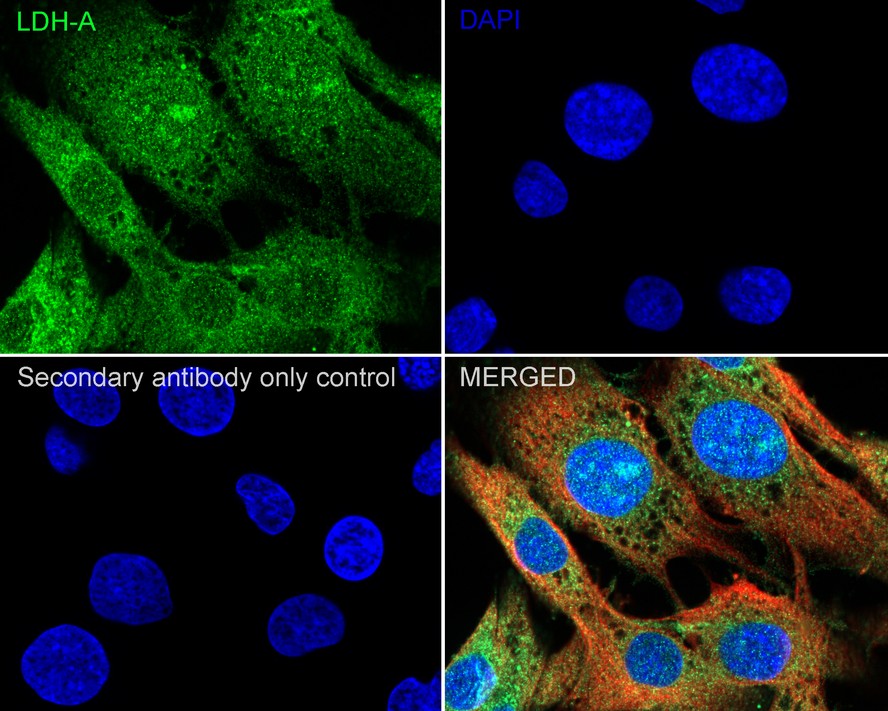
|
Fig8:
Immunocytochemistry analysis of C6 cells labeling LDHA with Rabbit anti-LDHA antibody (ER00702) at 1/100 dilution. Cells were fixed in 4% paraformaldehyde for 20 minutes at room temperature, permeabilized with 0.1% Triton X-100 in PBS for 5 minutes at room temperature, then blocked with 1% BSA in 10% negative goat serum for 1 hour at room temperature. Cells were then incubated with Rabbit anti-LDHA antibody (ER00702) at 1/100 dilution in 1% BSA in PBST overnight at 4 ℃. Goat Anti-Rabbit IgG H&L (iFluor™ 488, HA1121) was used as the secondary antibody at 1/1,000 dilution. PBS instead of the primary antibody was used as the secondary antibody only control. Nuclear DNA was labelled in blue with DAPI. Beta tubulin (M1305-2, red) was stained at 1/100 dilution overnight at +4℃. Goat Anti-Mouse IgG H&L (iFluor™ 594, HA1126) was used as the secondary antibody at 1/1,000 dilution. |
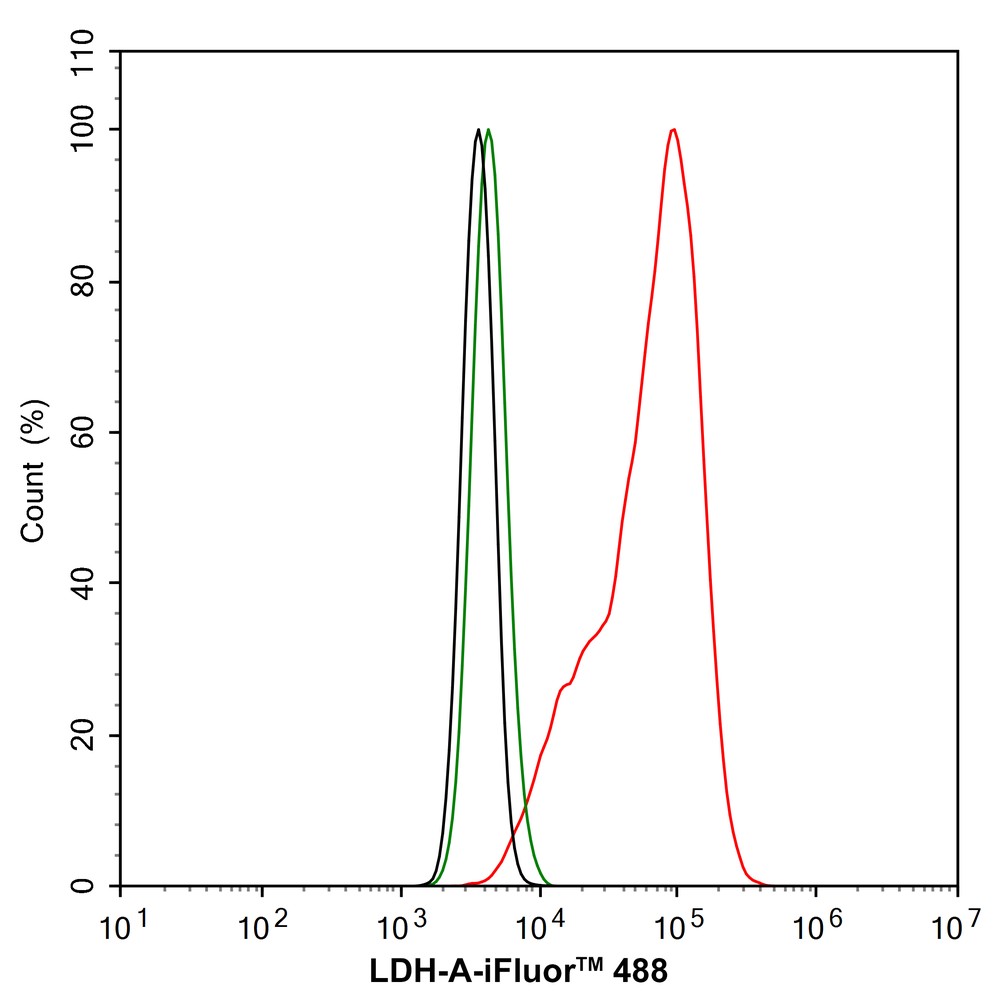
|
Fig9:
Flow cytometric analysis of A431 cells labeling LDHA. Cells were fixed and permeabilized. Then stained with the primary antibody (ER00702, 1/1,000) (red) compared with Rabbit IgG Isotype Control (green). After incubation of the primary antibody at +4℃ for an hour, the cells were stained with a iFluor™ 488 conjugate-Goat anti-Rabbit IgG Secondary antibody (HA1121) at 1/1,000 dilution for 30 minutes at +4℃. Unlabelled sample was used as a control (cells without incubation with primary antibody; black). |
Note: All products are “FOR RESEARCH USE ONLY AND ARE NOT INTENDED FOR DIAGNOSTIC OR THERAPEUTIC USE”.